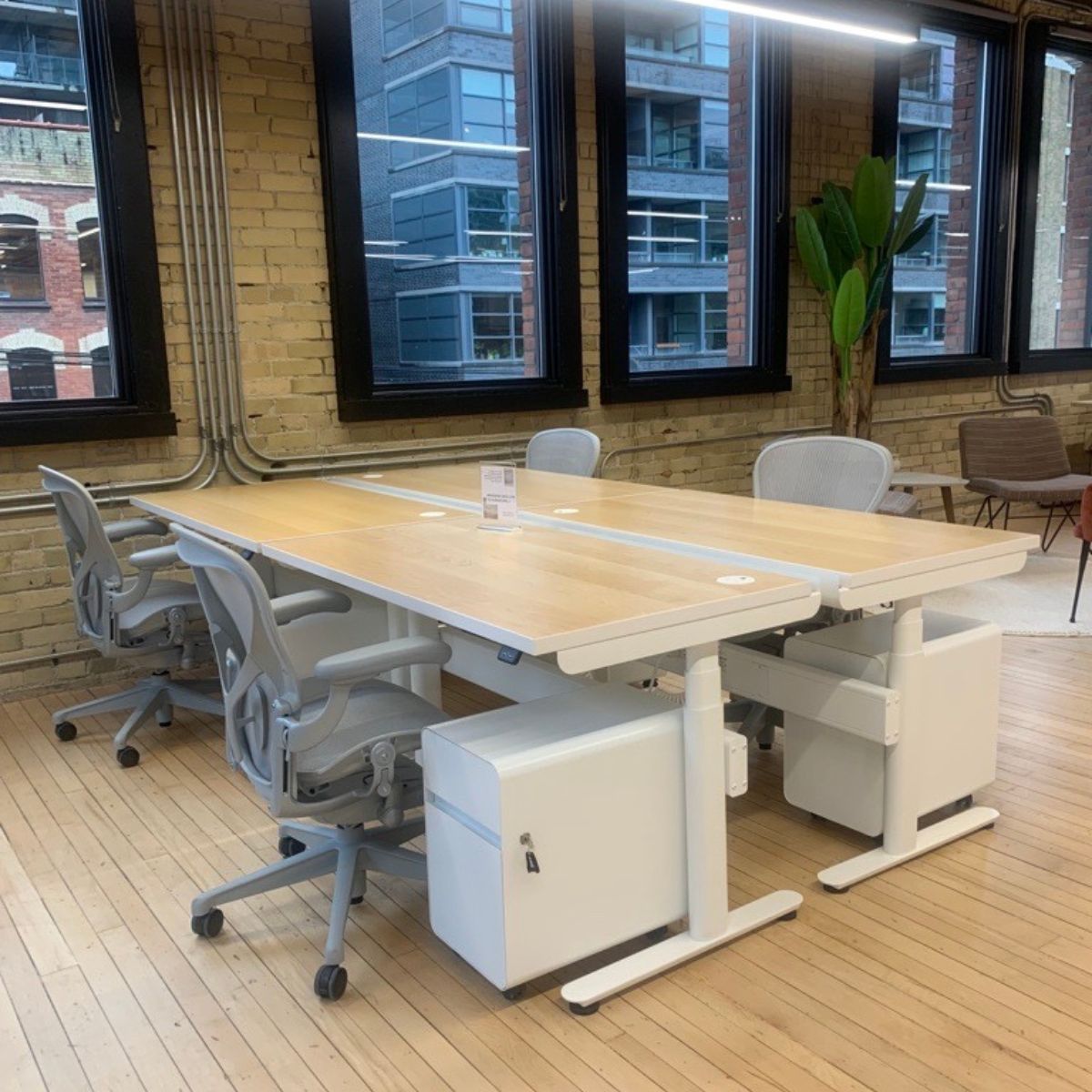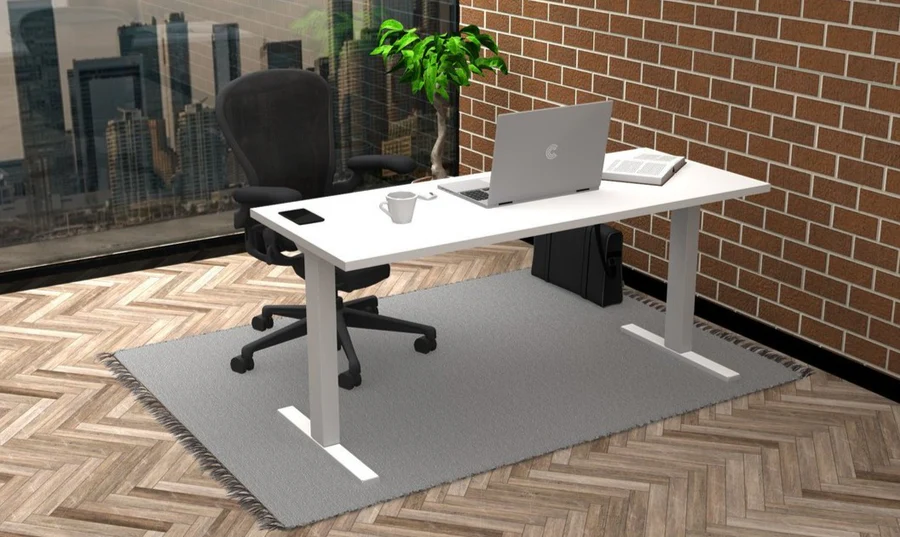
EMPLOYEE WELLNESS AND PRODUCTIVITY: STANDING DESKS IN MODERN WORKSPACES
With hot desking and hybrid work arrangements on the rise, the versatility of standing desks empowers employees to tailor their workspace, whether at home or in the office, to their specific needs. There are numerous health benefits linked to using standing desks, including research-based evidence that it can mitigate the risks of obesity, diabetes, cardiovascular disease, and musculoskeletal disorders associated with prolonged sitting. Beyond health, these desks also enhance productivity and comfort by enabling users to regularly change positions, ward off fatigue, and improve concentration.
So, what exactly is a sit/stand desk? A standing desk, or stand-up desk, is a workstation that allows you to work comfortably while standing. These desks are often adjustable, allowing users to alternate between sitting and standing positions.
WHERE WE STARTED: A BRIEF HISTORY
Early Designs (16-18th Century): Sit-stand desks have a surprisingly long history, with roots tracing back to the 16th century. In 1626, the University of Cambridge became the first educational institution to introduce standing desks for its students. The university believed that standing during learning and writing activities would foster deeper intellectual engagement and thought! Some of the earliest designs were rudimentary compared to modern standards but nonetheless innovative for their time. These desks were often crafted from wood and featured manual height-adjustment mechanisms, such as cranks or pulleys, allowing users to customize the desk height to their preference.
Height-Adjustable Mechanisms (Mid-20th Century): The mid-20th century saw significant advancements in office furniture design, including the widespread adoption of height-adjustable desks in workplaces. These desks represented a departure from traditional fixed-height models, offering workers the flexibility to transition between sitting and standing positions throughout the day. Typically featuring simple mechanical mechanisms like hand cranks or levers, these desks allowed users to easily adjust the desk height to accommodate their ergonomic needs. This innovation marked a pivotal moment in workplace ergonomics, as it recognized the importance of providing workers with options to promote comfort and productivity.

Where We Are Today:
Today, standing desks come in various forms to cater to different preferences and needs:
- Electric Standing Desks feature effortless height adjustment through electric motors, offering precise control and customization.
- Manual Standing Desks provide a more affordable option, operated with crank or lever mechanisms, still providing the benefits of sit-stand functionality.
- Converter Standing Desks are designed to sit on existing desks, offering a cost-effective solution for those seeking to introduce standing into their workspace without committing to a full standing desk setup.
Additionally, advancements in technology, design, and materials offer a seamless blend of form and function, promoting better posture, reducing sedentary behavior, and boosting productivity by tailoring workspaces to individual ergonomic requirements. Some of these advancements include:
Materials and Design: As materials science and design principles advanced, sit-stand desks have became more refined and durable. Manufacturers now use materials such as steel, aluminum, and high-quality wood to create desks that are both sturdy and aesthetically pleasing.
Electric and Hydraulic Systems: Electric and hydraulic systems are now commonly used for adjusting the height of sit-stand desks. These systems offer smoother and quieter operation compared to manual adjustments, making it easier for users to switch between sitting and standing positions.
Integration with Technology: Many modern sit-stand desks come equipped with built-in technology features, such as programmable height presets, smartphone apps for tracking usage, and reminders to change positions throughout the day.

WHY CHOOSE A STANDING DESK?
Standing desks offer numerous health benefits, including reducing the risk of obesity, diabetes, cardiovascular disease, and musculoskeletal disorders associated with prolonged sitting and are a valuable addition to any workspace, promoting employee health and productivity in the modern workplace. They also:
- Improve blood circulation, decrease back and neck pain, and alleviate discomfort caused by poor posture.
- Boost energy levels, enhance mood, and increase calorie expenditure, contributing to better overall physical and mental well-being.
- Increased productivity and comfort, including the ability to change positions regularly, prevent fatigue, and improve concentration.
THE BOTTOM LINE: WHY DOES THIS MATTER?
Investing in standing desks for staff can result in significant financial benefits for companies. For example, standing reduces the risk of sedentary-related health issues, such as obesity and musculoskeletal disorders. Companies may see a reduction in healthcare costs associated with absenteeism, sick leave, and medical claims. Additionally, standing desks can boost employee morale and satisfaction, leading to increased retention rates and reduced recruitment and training expenses.
Incorporating standing desks also aligns with key ESG and WELL metrics. A study published in the American Journal of Preventive Medicine found that using a standing desk for at least half of the workday led to a 32% reduction in the likelihood of developing obesity over a 5-year period. Additionally, a systematic review of research published in the European Journal of Preventive Cardiology concluded that standing desks can significantly reduce sedentary time and improve metabolic health markers, such as blood sugar levels and cholesterol levels, and research conducted by Texas A&M University’s Health Science Center found that employees who used standing desks experienced a 46% increase in productivity compared to those who remained seated throughout the workday. This increase in productivity was attributed to factors such as improved focus, alertness, and energy levels.
From an environmental perspective, choosing pre-owned or remanufactured options, like what we do here at Envirotech, can contribute to a company’s sustainability efforts by reducing carbon emissions, which are accumulated by extracting materials for new products. It can also offer significant cost-savings.
Socially, providing ergonomic workstations demonstrates a commitment to employee welfare and safety, enhancing workplace satisfaction and fostering a supportive corporate culture. Standing desks also align with the WELL Building Standard, which prioritizes occupant health and wellness through features such as ergonomic design and physical activity promotion.
GET ‘STANDING’ TODAY!
By prioritizing employee health and well-being, companies demonstrate their commitment to social responsibility and create a more attractive proposition for environmentally and socially conscious investors while also leading to tangible benefits such as improved employee health, increased productivity, and enhanced corporate reputation.

CONNECT WITH US
Ready for the benefits of a modern workspace with premium sit/stand solutions? Reach out to one of our workplace consultants today to discover our range of warrantied certified pre-owned, remanufactured, or new options tailored to your space. Connect, here! Looking to elevate your home office? Check out Envirotech’s sit/stand for home, here!

